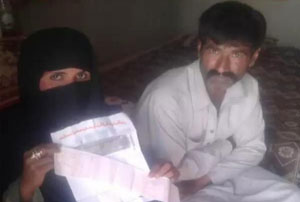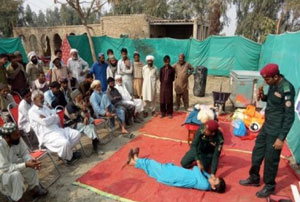“It was a horrible night. My husband complained of pain in his chest, and before we could do something about it, he fainted”, said Bilquees – a mother of five and resident of Basti Ludhani Chandia which is a small far-flung riverine community without proper health care facilities in Tehsil Kot Adddu, district Muzaffargarh.
She described her husband Nazar Hussain’s situation as being lifeless with minimal breathing. It created panic in the family. Children were terrified; the younger ones started crying. However, Bilquees remained in her senses and recalled the first aid training she had recently received.
She began performing Cardiopulmonary Resuscitation (CPR) on Nazar. The first attempt failed, but the second attempt showed signs of improvement in the patient. She continued with it and soon Nazar started breathing again. It was a huge relief for the entire family. “It was like a second life for the entire family. Children’s tears turned into smiles”, said Bilquees as she recalled the fateful night.

The next morning, she took Nazar to hospital where the doctor confirmed that Nazar had a cardiac arrest, and that CPR played an instrumental role in saving his life. Since then, Nazar has been visiting the hospital regularly and taking medicine. After a couple of days’ rest, he returned to his job and is now taking care of his responsibilities as the sole breadwinner of the family. He feels immensely grateful to Bilquees for saving his life.
Bilquees Bibi gives credit – for saving her husband’s life – to the training camp arranged by Society for the Advancement of Nature, Justice and Health (SANJH), with the support of Ambassador’s Fund Grant Program (AFGP). She, as a member of Community Resilience Committee (CRC), was among the 189 women belonging to 14 villages of Kot Addu, Muzaffargarh who received disaster preparedness trainings which included provision of first aid and performing CPR, among other things.

SANJH, during the six-month project, aimed to improve the mechanisms to reduce risks and enhance capacity of communities to respond to emergencies and disasters for protecting lives, property, and taking measures to contain the damage and disruption.
The target communities are confident that they can deal with disasters especially floods and soil erosion, minimize losses, and protect their people, crops, and livestock from damage and destruction caused by natural and men-made disasters.




















